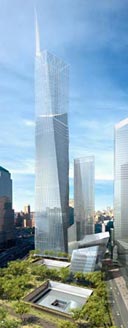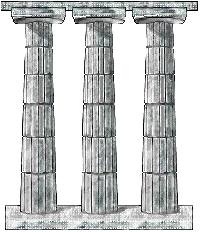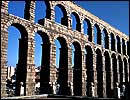| (insert your NIE or newspaper logo here) | Weekly Online LessonOnline Lesson ArchiveGrade Level: 6-8
|
Built To Last
 Nearly four years after the Twin Towers fell in New York City on
September 11, 2001, the plan to build the memorial at the site is facing
yet another redesign of its original blueprint.
Nearly four years after the Twin Towers fell in New York City on
September 11, 2001, the plan to build the memorial at the site is facing
yet another redesign of its original blueprint.
The site's master plan was chosen in 2003 with input from the American public and based on proposals submitted primarily by professional architects. The winning design includes the "Freedom Tower," which will stand about 1,800 feet from ground level, making it the world's tallest building.
On Wednesday, May 18, 2005, the Lower Manhattan Development Corp., the agency in charge of developing the memorial site, announced that due to security concerns some changes would be made to the Freedom Tower's design. Architects believe that only the lower 15 feet of the building will be modified, while the remaining height will generally stand as planned.
Following the announcement, well-known businessman and real estate developer Donald Trump explained during a news conference that he thought the memorial plan should be replaced by his own proposal - basically, a reincarnation of the original Twin Towers, but taller and stronger.
Trump added that the Freedom Tower design "is the worst pile of crap architecture I have ever seen in my life."
Clearly, architectural choices not only serve certain functions, like as an office building or public memorial, but they also illustrate differences in personal taste.
Furthermore, architects must balance what a client - in this case, the general public - wants as designed on paper with what is possible to actually engineer in real life.
To get an architect's point of view, this week you'll face the challenges of building big, functional structures, like bridges, domes and skyscrapers. Then you'll turn your talents to satisfying clients who have hired you to design their new home.
Building Big
 Your basic training begins at PBS, where you'll learn how to be
successful at Building
Big.
Your basic training begins at PBS, where you'll learn how to be
successful at Building
Big.
To get a feel for things, let's start in The Interactive Labs.
First, experiment in the Forces Lab - Squeezing, Stretching, Bending, Sliding and Twisting.
Where do you see these different forces in materials used around your own neighborhood?
Next, see how different factors affect Loads on a structure. In what ways does a structure's location and function influence its design?
In the Materials Lab, you'll discover the properties, pros and cons, and applications of different building materials.
How do the strengths and weaknesses of each material compare to the others? What are the primary materials used to build the homes and businesses in your area? For what applications are they used and why?
As you'll soon learn, Shapes are also important to think about for ensuring structural stability. Around town, look for different uses of the square, circle and triangle, along with clues as to how they have been strengthened to resist breaking.
 Now that you've got the basics under your belt, let's go build
some
Bridges!
Now that you've got the basics under your belt, let's go build
some
Bridges!
Start with Bridge Basics, and compare the differences between beam, truss, arch and suspension bridges. What kinds of shapes are used in these bridges? What are the pros and cons of each bridge type?
Next, travel to Craggy Rock for The Bridge Challenge. Help the city solve its bridge needs at all four locations. What factors determined your choices? Which factors related to the bridge's function? Which related to location or aesthetics?
Browse through the other types of big building projects and challenges - Domes, Skyscrapers, Dams and Tunnels - for more insight into how engineering genius has influenced the way we live.
What types of forces must each type of structure resist? What happens when the forces overpower the structure's stability? What changes in science and technology influenced the evolution of architecture over the years? What kinds of physical limitations do the forces impose upon a structure's artistic design?
Building Homes Wright
 Okay, so now that you've handled the big stuff, let's get personal
at the Architect
Studio 3D.
Okay, so now that you've handled the big stuff, let's get personal
at the Architect
Studio 3D.
Here, you'll get some lessons from one of the modern masters of home building, Frank Lloyd Wright.
Start your introduction into what architects do, then find out more About Architecture by reviewing the Architect's Handbook and browsing the gallery of Designing for People and Place.
It's always a good idea to get some guidance from the best in the business, so also take time to learn About Frank Lloyd Wright. Look into his Life & Career, and check out his Residential Designs and Public Buildings.
In what ways did Wright revolutionize architecture? What inspired his work? What did people like about his designs? What were some of the challenges he faced in completing each project?
Now you're ready to Enter Design Studio. (Those on slower Internet connections should try the Non-3D version.)
 View
the various Clients, and choose one, with or without one or more
family members or friends. Then choose a Location.
View
the various Clients, and choose one, with or without one or more
family members or friends. Then choose a Location.
Based on your client and the location, choose the Floor Plan, House Height, Exterior Materials and Roof.
Next, move into the home's Interior, where you'll plan the kitchen, bedrooms, dining room, etc. and pick out the wall coverings, windows, doors, and furnishings.
If you're in 3D mode, you can click from the 2-dimensional Plan View to 3D View to see how your plan is developing. When you're done with the design, you can Tour House.
How well does your design fit the functional needs and personal taste of your client? Does the design make sense for the home's location? What factors influenced your choices the most?
Newspaper Activities
In current issues of The Salt Lake Tribune, look for photos of homes or commercial buildings. What types of shapes and materials have been used? Can you tell if the materials are breaking under stress anywhere or if they have been repaired since its original construction? Also, look for any stories about new buildings going up. If it's a commercial or public building, what will be its function? In what ways is the architect balancing the structure's function with acceptable aesthetics? If the structure was built in another region of the country or world, how might the design be different and why? If the story mentions any challenges with the design, are they related to engineering principles, functionality, or personal taste? If you find a story about a historic building being renovated, what are some of the challenges to restoring it?
© Copyright 2005
Learners Online, Inc.
